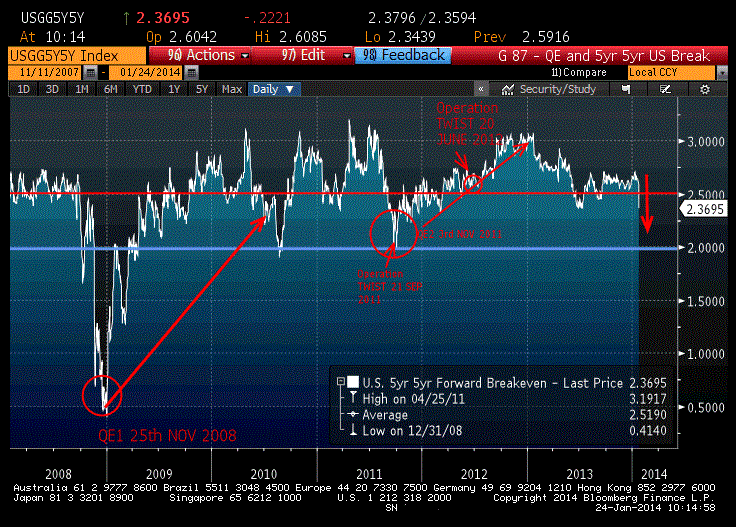High Correlation Suggests Mispriced Stocks Abound (Guest Post)
Post on: 11 Апрель, 2015 No Comment

High Correlation Suggests Mis-priced Stocks Abound (Guest Post)
Stock price movements have become highly correlated, with correlations reaching levels not seen since 2008. This is not surprising given historical data and should end up being a temporary occurrence.
Correlation, in financial terms, is a mathematical model that indicates how closely the returns of various assets match each other. Correlations can range from +1.0 (assets have returns that move in lockstep together) to -1.0, (assets have mirror opposite returns). Correlations may be expressed in decimal format (e.g. 0.72) or percentage format (72%).
Over the long-term different types of stocks have varying correlations. Small-cap stocks, for instance, have a long-term correlation of 0.72 with large-cap stocks, according to the Ibbotson SBBI 2011 Classic Yearbook. This means that while small-cap stocks have similar returns to their bigger brethren, they do not always move in the same direction or experience the same magnitude of change. Thus, you get some diversification benefits by combining small- and large-cap stocks in a portfolio. (Mixing in micro-cap, developed foreign market and emerging market stocks into a portfolio provides even more diversification benefits.)
Even among large-cap stocks, long-term correlations stay below +1.0 due to differences in industries, business conditions and valuations. For example, the performance of Bank of America (BAC) is affected by factors that dont directly influence Apple (AAPL) or Exxon Mobil (XOM). Thus, under calmer market conditions, diversification benefits can be realized even among large-cap stocks.
During periods of market duress and volatility, correlations move toward 1.0. This is what is happening right now. Nicholas Colas, the chief market strategist for the ConvergEx Group, calculated that average correlations between the 10 major sectors of the S&P 500 have reached 97.2% for the 30-day period ended September 9, 2011. This is the highest correlation since 2008s financial crisis. Coincidently, Vanguard just issued a research note showing last months volatility in the S&P 500 as being the highest since the second half of 2008. Volatility brings higher correlations.
The big reason for the volatility and consequent high correlations are macro factors. Headlines about the U.S. economy, the lack of bipartisanship in Washington, and European sovereign debt problems have shifted the focus of institutional investors to the big picture, and away from individual company stories. (As todays drop in shares of Netflix (NFLX) showed, individual company stories arent being completely ignored, however.)
Rising correlations diminish the benefits of diversification and the potential excess return that can be realized by picking individual stocks. Correlations are not static numbers, however, and periods of higher correlations have historically been followed by periods of lower correlations. Therefore, it would be a mistake to assume that diversification has stopped providing benefits. More importantly, when the returns of stocks move in lockstep and ignore the fact that individual companies industry classifications, business models, financial status and valuations are different, many stocks become mispriced . And when stocks become mispriced, opportunities for astute stock-picking present themselves .
International Correlations Should Fall Too
International stocks are also displaying high correlations with U.S. large-cap stocks. Colas calculated the MSCI EAFE (Europe, Australia and the Far East) index as having a 96.2% one-month correlation with the S&P 500. Emerging market stocks had a 97.4% correlation.
Just as with U.S. domestic stocks, global stocks become more correlated during periods of market turbulence. These high correlations fall after the crisis passes, resuming the benefits of diversifying globally.
The Week Ahead
We will get an early look at third-quarter profits with some of the traditional early reporters within the S&P 500 announcing their results. Those companies are Adobe Systems (ADBE), AutoZone (AZO) and ConAgra Foods (CAG), which report on Tuesday; Bed Bath & Beyond (BBBY) and General Mills (GIS), which report on Wednesday; and CarMax (KMX), FedEx (FDX) and Nike (NKE), which report on Thursday.
The Federal Open Market Committee will hold a two-day meeting, starting on Tuesday. The committees statement, which will be issued on Wednesday afternoon, will be scrutinized closely. Specifically, economists and traders will be looking to see if the Fed announces a new form of stimulus, such as buying long-term Treasury bonds. The committee was divided during the August meeting on whether additional actions were needed by the Federal Reserve to spur economic growth, and it is uncertain whether anything will be announced following this meeting.
Beyond the Fed meeting, there is not much on the economic calendar. The National Association of Home Builders will release its September housing market index on Monday. Tuesday will feature August housing starts and building permits. August existing home sales will be published on Wednesday.
The Treasury Department will auction $11 billion of 10-year inflation-protected bonds (TIPS) on Thursday.
No Federal Reserve officials are currently scheduled to speak publicly.
The views and opinions expressed herein are the author’s own, and do not necessarily reflect those of EconMatters .
About The Author — Charles Rotblut, CFA is the VP for American Association of Individual Investors & AAII Journal Editor. Charles is also the author of Better Good than Lucky (W&A Publishing/Trader’s Press). (Author archive at EconMatters here .)














